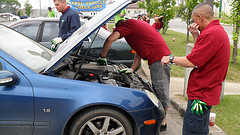April is Car Care Month, and for good reason. Motorists can undo the wear and tear of winter driving and get their vehicles ready for summertime’s heat, humidity, and heavy stop-and-go traffic.

flic.kr/p/bXKjTY
The experts at the non-profit National Institute for Automotive Service Excellence (ASE) offer the following tips on getting your vehicle ready for summer.
- Read the owner’s manual and follow the recommended service schedules. The manual contains a complete checklist of services and schedules and other important information about your vehicle.
- Flush and refill the cooling system (radiator) according to the service manual’s recommendations. The level, condition, and concentration of the coolant should be checked periodically. If you are doing your own work, make sure the engine has cooled down before removing the radiator cap.
- Have engine performance problems–hard starts, rough idling, stalling–corrected. You’ll get better gasoline mileage and you might just prevent more expensive repairs later on. For example, something as simple as a rough idle could indicate an underlying problem that could ruin your vehicle’s catalytic converter over time. The old adage, “Pay me now or pay me later,” is especially true with today’s high-tech, computerized systems.
- If you are not a do-it-yourselfer, look for repair facilities with vehicles in the parking lot equal in value to your own, modern equipment in the service bays, and signs of qualified automotive technicians as evidenced by trade school diplomas, certificates of advanced course work and training classes, as well as national certification of the individual technicians by ASE.
- The tightness and condition of belts, clamps, and hoses should be checked by a qualified auto technician. Most do-it-yourselfers do not have the proper equipment. But weekenders can look for signs of wear, cracking, or frayed belts. And, once again, don’t ignore the service schedules listed in the owner’s manual.
- Have a marginally operating air conditioner system serviced by a qualified technician. The air conditioners on older vehicles often contain environmentally dangerous ozone-depleting chemicals that could be released into the air through improper or incompetent service.
- Change the oil and oil filter as specified in owner’s manual. (Properly dispose of used oil–it’s environmentally damaging.) Poll after poll of technicians indicate that this is one of the most neglected services, and one that can greatly reduce the life of your automobile, light truck, or SUV.
- Replace other filters (air, fuel, PCV, etc.) as recommended in the service manual.
- Check the condition of tires, including the spare. Let the tires “cool down” before checking their pressure. You’ll save gas with proper inflation! Uneven wear, ‘cupping,’ vibrations, or ‘pulling’ to one side indicates problems with your tires or suspension system.
- Don’t neglect your transmission. Costly repairs can be prevented by routine service.
- For safety and convenience, inspect all lights and bulbs; replace burned out bulbs. Replace worn wiper blades and keep washer solvent on hand to fight summer’s dust and insects.
 The National Institute for Automotive Service Excellence (ASE) was founded in 1972 as a non-profit, independent organization dedicated to improving the quality of automotive service and repair through the voluntary testing and certification of automotive technicians. ASE-certified technicians wear blue and white ASE shoulder insignia and carry credentials listing their exact area(s) of certification. Their employers often display the blue and white ASE sign. Visitwww.ase.com for more information.
The National Institute for Automotive Service Excellence (ASE) was founded in 1972 as a non-profit, independent organization dedicated to improving the quality of automotive service and repair through the voluntary testing and certification of automotive technicians. ASE-certified technicians wear blue and white ASE shoulder insignia and carry credentials listing their exact area(s) of certification. Their employers often display the blue and white ASE sign. Visitwww.ase.com for more information.
Tagged with: long-term savings • service schedules
Filed under: Car Maintenance